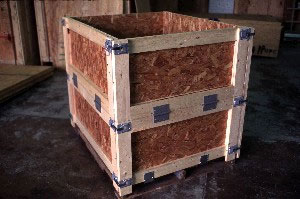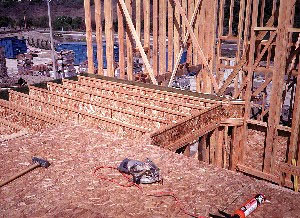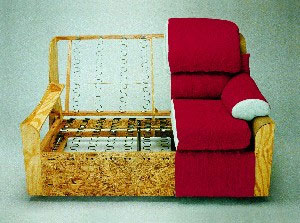 |
| Industrial uses for OSB include products like this
OSB crate, which can be folded flat to maximize space. Photo credit: APA-The Engineered Wood Association. |
Wood Firm
Drifts South
by ADAM BRUNS,
Site Selection
Managing Editor
One of the three
current production facilities from Canadian oriented strand board (OSB)
manufacturer Grant Forest Products is in High Level, Alberta. The company's
first U.S. manufacturing investment is setting a high level all its
own.
On June 7, Grant announced it would invest US$400 million in two separate OSB plants in South Carolina's Allendale and Clarendon counties, employing as many as 240 people, split evenly between the two facilities.
"South Carolina has a combination of resources
that we could not find anywhere else," said Peter Grant Jr., president
of the 24-year-old company. "We were looking for a willing, trainable
workforce, a government that understands the needs-and the value-of
 |
| South Carolina Dept. of Commerce 2004 CDG Uses of Funds |
Construction of the two Palmetto State plants will be staggered, with ground to be broken for the Grant's Allendale plant this fall, followed by Clarendon six months later. The chosen counties are rural territories in the southern half of the state: Clarendon County likes just southeast of Columbia, split by I-95, while Allendale County has its western border defined by the Savannah River that forms the state line with Georgia.
The Toronto-based company is growing where it's planted too. Its current job openings in Canada as of the date of the South Carolina announcement numbered 24, at positions ranging from wood scientist or senior resin chemist at its administrative HQ in Earlton, Ont., to seven licensed millwrights at Grant's plants in Timmins and Englehart, Ont.
The plywood alternative is not only popular in residential and commercial construction, but also for material handling and upholstered furniture applications. And certainly the Carolinas are known for their furniture makers. Grant also makes specialty OSB products, including oversized panels, rim board, web stock, and edge swell-resistant flooring.
 |
| An engineered wood products floor system can include OSB sheathing, I-joists, LVL and rim board. Photo credit: APA-The Engineered Wood Association. |
The product came into being in 1978 as the next-generation alternative to waferboard. According to the Structural Board Association (SBA), the material's North American production level stood at 7.6 billion sq. ft. (706 million sq. m.) in 1990, surpassed plywood in 2000, and by 2001 had grown to 22 billion sq. ft. (more than 2 billion sq. m.).
Leaders of Grant Forest Products' Englehart mill accepted the SBA's Ron Baker award for Excellence in OSB Manufacturing in May 2004, an honor the facility also earned in 1996 and 2001. The award is named after a former Grant senior manager who also served as SBA chairman.
By 2004, OSB was expected to account for 60 percent of the North American panel market, and is making significant inroads in other countries like Japan, which is updating its building codes to allow for more wood-frame construction. Louisiana Pacific leads the world in OSB production.
According to a 2004 industry forecast by APA-The Engineered Wood Association, the industry added nearly 13 billion sq. ft. (1.2 billion sq. m.)of OSB production capacity between 1994 and 2001, but "only about four billion square feet [371.6 million sq. m.] of new capacity is currently forecast to come on line between 2002 and 2008."
U.S. and Canadian production of structural wood panels (plywood and oriented strand board) totaled a record 42.7 billion sq. ft. (3.97 billion sq. m., 3/8-inch basis) in 2004, up 4.5 percent from 2003 and driven primarily by the booming U.S. housing market, says APA. OSB production for the year rose 7.3 percent, to 25.37 billion sq. ft. (2.36 billion sq. m.), while plywood volume increased 0.6 percent. According to APA, "U.S. and Canadian structural panel consumption increased 6.4 percent for the year, with the difference between increased demand and production bridged by panel imports, which were up 68 percent. Most of that increase was plywood entering the U.S. from Brazil."
The SBA touts its product's renewable raw-material base, consisting primarily of small-diameter fast-growth trees like the pines that populate South Carolina and Georgia.
 |
| Furniture makers often use a combination of plywood and OSB for upholstered furniture framing. Photo credit: APA-The Engineered Wood Association. |
In 2004, in the South Caroline Dept. of Commerce's Rural Infrastructure Fund (RIF) provided $11.7 million to 20 of South Carolina's most challenged counties. In addition, the state's Community Development Block Grant (CDBG) program awarded $33.8 million to 89 projects in rural communities, for projects including rehabilitating neighborhoods and housing, improving community infrastructure, providing public facilities, and creating or retaining jobs.
South Carolina Gov. Mark Sanford said the two Grant Forest Products plants would have a ripple effect on state-level economic development. Comments by him and by his Commerce Secretary Bob Faith made the connection between income tax breaks at the corporate level and income at the resident level.
"We've got tremendous competitive advantages and a unique quality of life here that you don't find in many other states, and our focus continues to be on expanding those advantages so that more companies like Grant Forest Products bring jobs and investment here as opposed to elsewhere," said Sanford. "For us, that starts with additional income tax relief that will stimulate economic growth across all sectors of our state's economy."
"Our forestry sector is an integral part of our state's economy, especially when it comes to bringing growth to our rural areas and making sure we're focused on raising income levels in every part of South Carolina," said Faith.
©2005 Conway Data, Inc. All rights reserved. Data is from many sources and is not warranted to be accurate or current.